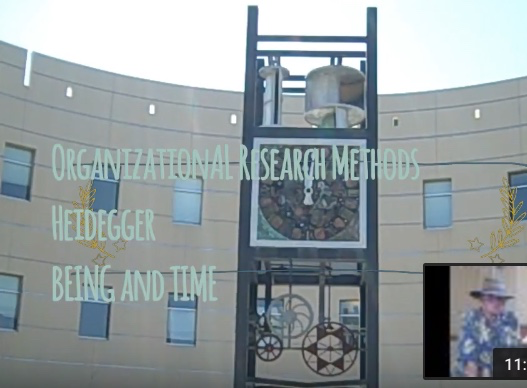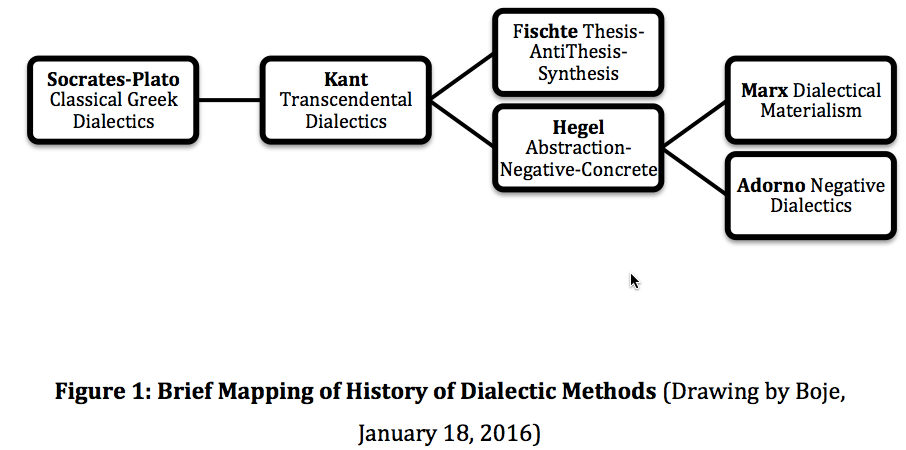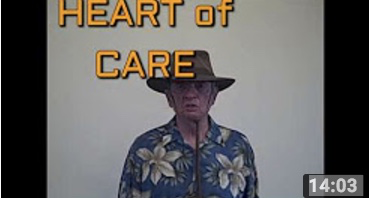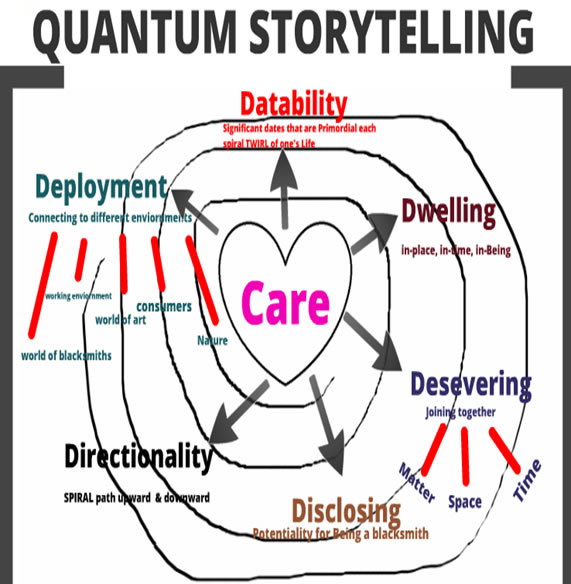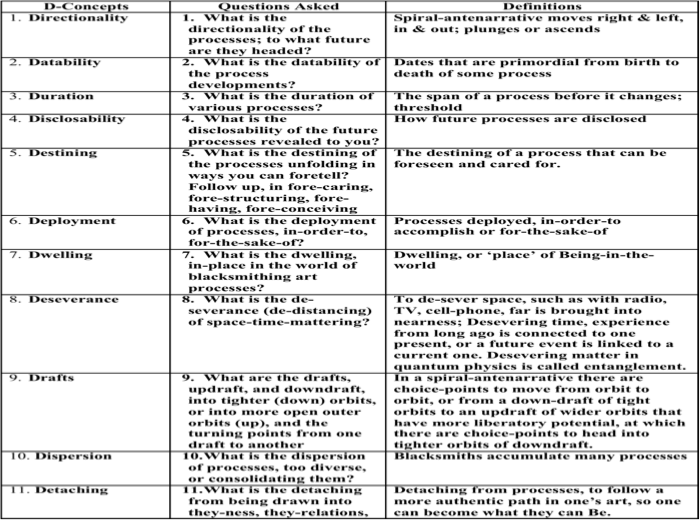Organizational Research Methods: Storytelling in ActionDavid M. Boje Book being prepared for Routledge, due March 2018 To cite this document: Boje, David M. (2018) "Organizational Research Methods: Storytelling In Action", (March 15), URL = <https://davidboje.com/ORM_Storytelling_in_Action_Book/index> |
STREAM 3 - Martin Heidegger's relational process ontology
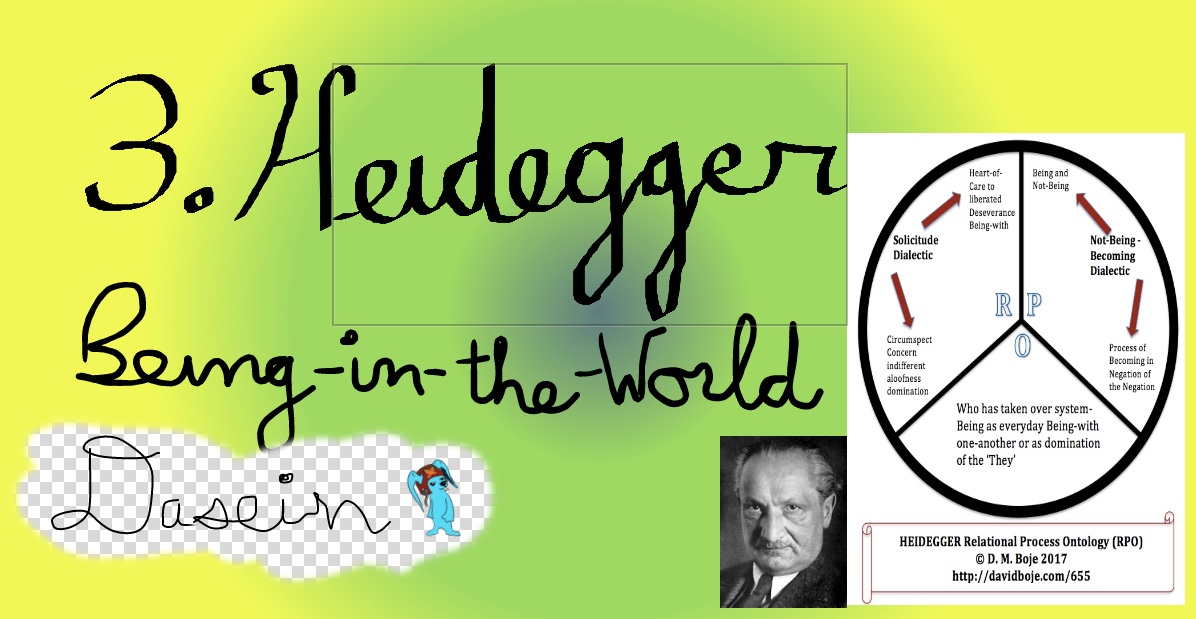
Please see Hegel Study Guide in preparation for Heidegger's ontology
Heidegger ontology featured in Boje's organizational research methods or for louder version (but with filmora logo) click here; another way to bring up volume is VLC playback with audio enhancement.
Heidegger, M. (1962). Being and Time. Translated by John Macquarrie & Edward Robinson. NY: Harper Row. 1927 in German, 1962 English translation, see searchable online FREE text that begins and ends with problematizing Hegelian dialectics for having a linear construct of temporality, and being too ideal about synthesizing thesis and antithesis forces. You can also compare the 1962 and 1996 translations. See --> Heidegger, Marin. (1996). Being and Time. Translated by Joan Stambaugh. NY: State University of New York Press. Downloadable pdf that is NOT searchable
Heideggerian RPO has been ably applied in the strategy-as-process standpoint (Chia, 1999; Langley, Smallman, Tsoukas, & Van de Ven, 2013; Chia & MacKay, 2007). It is also prominent in my own work (Boje, 2014) and is basis of antenarrative theory of ‘fore-caring’ in my work with colleagues (Boje, Haley, & Saylors, 2016; Boje, Svane, & Gergerich, in press; Haley & Boje, 2014; Svane & Boje, 2014, 2015). ‘Fore-caring’ includes fore-having, fore-conception, fore-structuring, and fore-sight. Heideggeran RPO lacks the focus on the political found in work by Arendt (1958) and Follettian PRO2.
What Heidegger has to offer. It has become the basis for the process school of strategy, stragety as practice, ways to deconstruct organizational systems, and my own work on antenarrative
Some work by amazing colleagues:
Chia, R. (1999). A ‘rhizomic’model of organizational change and transformation: Perspective from a metaphysics of change. British journal of management, 10(3), 209-227;
Langley, A., Smallman, C., Tsoukas, H., & Van de Ven, A. H. (2013). Process studies of change in organization and management: Unveiling temporality, activity, and flow. Academy of Management Journal, 56(1), 1-13. and
Chia, R., & MacKay, B. (2007). Post-processual challenges for the emerging strategy-as-practice perspective: Discovering strategy in the logic of practice. Human relations, 60(1), 217-242.
ACTS IN WRITING UP HOMEWORK TO INITIATE TERM PROJECT
Study your term project 'organizational system'. I lists some ACTS to help you through this.
FIRST 'ACT' of HOMEWORK BEGIN HERE - search for 'Hegel' and for 'dialectic' in searchable online FREE text you will that Heidegger has a project to redo Hegel's two dialectics that Sabine spoke of (1) thesis-antithesis-synthesis, and 2) Being opposed by Not-Being, which are the Becoming brought out by the negation of the negation. We wll call them by synthesis model and the process of becoming model. The question is how does Heidegger change Hegel dialectic? My read is he wants a different conception of time, as the temporalizing of temporality" (Heidegger, 1962: #436). He wants the becoming model of dialectic (negation of the negation) to be in-time Ready-to-hand rather than Hegels time that is Present-at-hand (but not Ready-to-hand). The distinction is that Hegel is putting time outside Being into abstract concept, having time enter as "punctuality" (Heidegger, 1962: #432-3) and Hegel is making Spirit into an "absolute-ngativity" (#433). Hegel refers to the second model of dialectic (becoming) in how the restless Spirit keep on negating of for negation, actualizing itself in history, not detaching the excluded, but surmounted "making-itself free" (#434) in progress not in quantitative, but in qualitative quality of Spirit.
Within your homework acts there are some steps of moving through space in time, tarrying for a while, encountering your very own organizational system of study.
HINT: STEPS TO HERMENEUTIC METHOD OF SPACETIME OF SYSTEM RESEARCH
What is a Hermeneutic step? STEP is an act or body-movement of putting one leg in front of the other in walking or running in space. Step is particular way of walking, a gait, a stride, or a cadence rhythm in time. You actually have to take step, Being-in-the-world of your system to do hermeneutic interpretative method. Of course, Heidegger did not pose steps, but learning to walk, one step after another, important before you move through spacetime at a run.
STEP 1 in HERMENEUTIC METHOD: Get into your system, start walking about: Look at space of system and environment, non-circumspectively, "just looking at it" at the "environmental regions", the "spatiality of the environment", and not calculationg, not being metrical about space, rather look at "involvement" as "ready-to-hand" becomes "spatialized" [verraculicht] (Heidegger, 1962 Being & TIme: #112). Approach "Being-in-the-world" non-thematically, not with Cartesian (agential cut) of "res cogitans" (subjective) or with "res extensa" (extended thing/object) (#114) because that is Cartesian Dualism that the Heidegger dialectic seeks to overcome.
Look at both space and at time, and at spacetime because Heidegger is retheorizing Hegel's dialectic with different Notions of spacetime. We will get to dialectic, for now, be informed of Heidegger's dialectic project, that from beginning to end of Being & Time, its about changing the dialectic of space and time (or spacetime):
"If space gets represented-that is, if it gets intuited immediately in the indifferent subsistence of its differences-then the negations are, as it were, simply given." (#430).
"'Time, as the negative unity of Being-outside-of-itself, is likewise something simply abstract, ideal. It is that Being which, in that it is, is not, and which, in that it is not, is: it is intuited becoming" (#431).
INTUITED BECOMING: "For this interpretation, time reveals itself as 'intuited becoming'.According to Hegel this signifies a transition from Being to nothing
or fr om nothing to Being. Becoming is both arising and passing away. Either Being 'makes the transition', or not-Being does so. What does this mean with regard to time ? The Being of time is the "now". Every "now", however, either 'now' is-no-longer, or now is-not-yet ; so it can be taken also as not-Being. Time is 'intuited' becoming'" (#431).Here is a drawing of the key concepts of Heidegger Relational Process Ontology
Figure 2: Heidegger Relational Process Ontology
STEP 2 in HERMENEUTIC METHOD is very strange questioning: While tarrying for a while, Ask "Who are the ways" of behavior and doing of 'organizational system'? (#114-115). Look for the "Who" of system that are 'selfsame' (#115)that does not change as its Experiences and ways of behavior (doing) change. The ontological quesiton of 'Who' is ontically obvious, but stay with it because it leads to ontological hermeneutic Interpretation. Ontic, the Who is people, living molecules, maybe Swainson's Hawks flying in territory in season, and ontically are present-at-hand to the Who of system. Ontologically, the 'Who' is answered by the 'they' and is not ontologically grounded, not yet. In step 2, we are at the interplay of ontico-ontological: not a kind of Being "grounded in the Being of Dasein itself" (#116).
Boje: "I am a human being (in Being of Existence) not a line item in a [circumspect] spreadsheet" (Thursday 31 August, 4:25PM at a department meeting. My 'I-hood' [Ichheit] in the organization system, in sense of I have lost myself. This is an expression of alienation, of being ontically in the lens of the Who that is circumspect.
Colleague: "David you have important place in this department." This is what I call an ethic of care, a heart-of-care for my Being-in-the-world, and it is a Being-with that is ontological.
Heidegger: "Yet man's 'substance' is not spirit-as a synthesis of soul and body; it is rather existence" (#117). This can be read as an answer to Hegel's Phenomenology of Spirit, dialectic.
Who undertakes voyages within the organizational system? Who are the 'Others' you encounter in ready-to-hand and the present-at-hand relations and processes in ways of Being-in-the-world?
STEP 3 in HERMENEUTIC METHOD: While stepping about, 'see' and 'look' at every mode of Being-in-the-world. (#117-118). There are people, equipment, supplies, welfare, environment (including Nature) that we encounter as we look at organization system. Modes of Being inclued, Being-with, Being-alone, Being-among, Being-alongside, Being missing,Being-indifferent, Being-present-at-hadd, and Being-ready-to-hand (#121). One mode of Being is what I call heart-of-care, and its opposing dialectical Being is just concern, the 'object of concern" (#121). THe dialectice is called SOLICITUDE (Being-care-full, vs. Being-concern-full). In Being-concern there is circumspection, "object of concern" and the Other can "become one who is dominated and dependent" (#122), what Follett (1945) called POWER-OVER. In Heart-of-care, there is POWER-WITH of "Being-with". Heidegger wants to give care back to WHO of authenticity, for first time "authentic 'care'" (#122). We encounter "supplier and "producer" who serves "well or badly" in a "field" belonging to such and such a 'Who' (a person or 'they') (#118). Others are encountered in ready-to-hand "environmental context of equipment" and "Nature present-at-hand" (#118).
Figure 3: Swainson's Hawks (not at NMSU), this year at NMSU there are 3 new born, now grown, ready to fly to Argentina, with parents, but not yet
Example: Its Sep 1, 2017, and there are 5 Swainson's Hawk (mama, papa, & 3 feldglings) that exist ontically and ontologically at NMSU. Hawks ontically are Others with samenss of Being-in organizational system and Being-in-Nature "environmentally ready-to-hand" (#119) in 'yonder; of the world, they are DWELLING in a place of Daisen that is for NMSU system only concern (present-at-hand) that Professor Carol Cambell and I are making with heart-of-care (ready-to-hand) as we look at co-existence. The Hawk's existence, 'Who' is "authentically spatial" without theoretical distortions of university (org) system calculations, metrics, or circumspection. Spatially Carol, Hawks, and I are 'desevering: (#120) becuse Haks are still in "existential spatiality" (#120).
What does circumspection mean? Heidegger uses the word throughout and in many forms. Circumpection is required in day-to-day exercise of NMSU administrative system and operational/facilities system. There is careful observation of Hawks as facilities people do 'look around' at the Hawks, and are cautious, careful, and the administrative order is 'careful not to take risks.' CIrcumspect means to look around so as to avoid mistakes and bad consequences, and be discreet in all buinsess dealings of the university, and a system is a WHO that takes the least risky choices. NMSU does not take risks! Biologists (& Birders) understand 'forewarning' in advance, the signs of a future event, and Carol and I, advise forewaring in advance of danger or attack by Sainson's Hawks (now 5 of them). Please use Umbrella or wear large hat. How to desever (de-distance) relation of human species and hawk species?
Figure 4: Left the old signage (very small on sidewalk), right painting by artist Virginia Maria Romero (used by permission).
STEP 4 in HERMENEUTIC METHOD: Inside the organization and its environment, step out some distances, both in walking and in realtionaity: What are the modes of Distance and Deseverance (de-distancing) of the organizational system? THe "Who" becomes a "What" in distancing that "thrives on distruct" and "leaps in and dominates" (#122). Care, on the other hand "Leaps forth and liberates: (#122-123). "Environmental circumspection" (#124) in "solitious concern" lacks "empathy" and is "unsociablitity" and/or "aloofness" (#124). Heidegger (#128) asks, "Who is it then, who has taken over Being as everyday Being-with-one-another?" Careabout the distance of relationships in systems tahd dispose of Others as they please, and Who is the who? Heidegger answers, its "the 'they'" who do neuter "distantially" and are not "grounded-with-one-another" (#126-127). What I call heart-of-care in organization systems is Heideggers "Dasien of its answerability:, its "distantiality, averageness, levelling down, publicness, the disburdening of one's Being" (#128). Search for the term, deseverance (desevering) throughout Being and Time.
How might we apply this to research methods, in study of organization system? In every change the system of organization has to ocercome itself, in an "unending battle against itself" (#434). The engeation of negation in dialectic-Becoming is a process of system change (& movement). System is an entity appearing in time, in world-history, in the becoming of system, and its demise. Heidegger's concern is twofold. First if Hegel treats entity (i.e. organization system) as an abstraction its not Being-in-the-world. Second, if the entity (for our interests organization system) is treated as thing, we have reified the entity which is a huge "ontological problematic" (#437). The Being of organization system from Heidegger's standpoint, in Hegel reamins unformulated and unclairifed. The result is we cannot research the organization ssystem because we are chasing an abstract system conception.
Look earlier in Heidegger's Being and Time, to section 101 to 104. In #101, the spatiality of entity (for us org system) is encountered in the environment, which is 'ready-to-hand, (#102-104), the spatiality of the environment (see also 60, 66, 89, & 112).
Heidegger turns to the last two very last sections (the ending paragraph) of Hegel's Phenomenology of Spirit,
"Systematic Science cannot, however remain a pure conceptual development: it must step out of itself and see Spirit developed in space and time and in Nature" (Hegel, 1807: #806-807). Hegel's Phenomenology of Spirit
A LONG PROCESS -- "It must then study Spirit returning to itself in time, i.e. in the long porcess of historical cultures and individuals" (Hegel, 1807: #808). This last one from Hegel's Phenomenology of Spirit
ACT 2 in homework: LOOK DEEPER AT HEGEL NATURE CONCEPT: According to Hegel (Encyclopaedia of the Philosophical Sciences (1830) Part One), in the Nature section of his Encyclopedia, "Philosophy of Nature" (click here for that).
NATURE IS SYSTEM WITH STAGES OF PROCESS section § 194. "Nature is to be viewed as a system of stages, in which one stage necessarily arises from the other and is the truth closest to the other from which it results, though not in such a way that the one would naturally generate the other, but rather in the inner idea which constitutes the ground of nature."
NATURE IS CONTINGENCY and 'Ens' and Non-Ens' -- section §193: "Hence nature exhibits no freedom in its existence, but only necessity and contingency. For this reason nature, in the determinate existence, which makes it nature, is not to be deified, nor are the sun, moon, animals, plants, and so on, to be regarded and adduced as the works of God, more excellent than human actions and events. Nature in itself in the idea, is divine, but in the specific mode by which it is nature it is suspended. As it is, the being of nature does not correspond to its concept; its existing actuality therefore has no truth; its abstract essence is the negative, as the ancients conceived of matter in general as the non-ens. But because, even in this element, nature is a representation of the idea, one may very well admire in it the wisdom of God." NOTE: non-ens and existence exist together in every part (Aristotle). click here for more on Hegel, Nature Philosophy
NATURE IS LIVING WHOLE, MOVEMENT IN STAGES OF IDEA- Section § 195. "Nature is, in itself a living whole. The movement of its idea through its sequence of stages"
ACT 3 in homework: NEXT FIND OUT WHAT IS HERMENEUTIC ONTOLOGY--> A wonderful 80 page text is Heidegger (1923/1988/1999) Ontology --- The Hermeneutics of Facticity translated by John van Buren.Bloomington & Indianapolis: Indiana University Press.It is available online for download as pdf.
What is Hermeneutic Ontological Method? Heidegger (1923: #1) begins "Ontology ... means doctrine of bieng" about existence in anitent Greek discourses about nature of existence. Modone ontology is about "ontology of nature, ontology of culture, material ontologies" we see in sociomateriality systems theory (Barad, for example). Heidegger finds the older and classic meanings of ontology inadequate to address Being-in-the-worl in time, in space. So he adopts to standpoint of 'Being-there', Dasein. The Hermeneutics of Facticity is a lecture Heidegger gave. Hereneutic ontology is a method that an be used in organization system studies, the meaning of Being-in-the-world, Being-there (Dasein), "for a while at a particular time... 'awhileness' of temporal particularity, cf. 'whileing' 'tarrying for a while, not running away, Being-there-at-home-in-being-there-involved-in..." (p. 5, Part One, caps of Being, mine).
Hermeneutics is traced to Greece variants and then on to more modern uses, until (p. 11) Heidegger settle into 'Hermeneutics as the self-interpretation of facticity'. Hermeneutic investigation of facticity is not an artifically devided mode of analysis (p. 12). Rather it is interpretation, not of grasping an object (that is ontic or empiricism, or positivism, if you prefer). Rather, facticity is to hermeneutically interrogate (or investigate) the character of Dasien's being, in being-possible, the ownmost possibility of be-ing (p. 12).
Phase 1: The forehaving of interpretation (p. 13), which for me is about antenarrative, forehaving (before) narrative coheres and turns retrospective. Forehaving is in advance of narrative sensemaking. As we say in Follett, it is all about "the situation" (Heidegger, 1923: 13), but of course Follett and Heidegger mean different concepts of situation, and its facticity, the forehaving "Being-on-the-way" in advance of is Heidegger, and for Follett, the Law of the Situation, is making the situaiton the invisible leader, so we have co-inquiry as to the facts of the situation, in settling conflicts, developing unity around differences co-investigated (by management and labor). For Heidegger forehaving is "the anticipatory leap forward and running in advance" (p. 13). In Being and Time (1962), Heidegger uses term 'historicality,' for this hermeneutic encounter with forehaving, and the term 'historicity' for the kinds of shallow, monological, petrified narrative retrospective sensemaking in many if not most corporate history, that glorifies the CEO, President, a few executives, leaving everyone else out-of-history.Whose photos are in the hall of the dean's office (other deans, corporate donors given awards, and hardly anyone else. See Microstoria and Grand Narrative chapters in Boje (2001).
Phase 2: Tarrying for a While. This is the idea in hermeneutic ontological method of getting factical understanding by having encounters with the system, tarrying for a while to understand relationality and process of the system, not as an abstract system concept or schemata, but byknwoing the factical itself, Being-theare in space, and Being-now in temporality (p. 15, 24).
Here is a mystery, a challenge to solve. It is a strange drawing in the printed copy of Hermeneutics of Facticity (p. 72). I rendered it below:
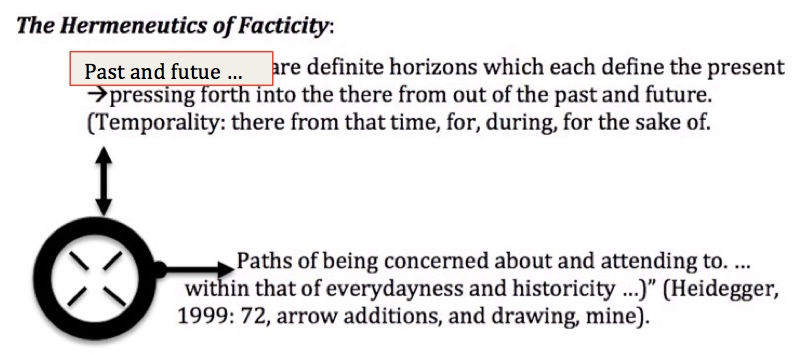
Figure 5: Hermeneutics of Facticity of Past and Future impacting concert Present
ACT 4 in homework: ASK THESE QUESTIONS ABOUT YOUR OWN 'Organization System' project: Heidegger above is asking some very basic ontological quesitons that we can ask about organizational systems (Heidegger, 1923: p. 72):
-
"What is it for?
-
What are we supposed to do with it?
-
Who is it for?
-
What is it supposed to be for?
-
Who made it?"
Finally, we can start to research our encounters with organizational systems in a concept of (see figure) of the hermeneutic method where past and futuree are theorized to both be pressing forth into the 'there' and fore the sake of care. And we can trace the paths of Being attended to, not in ABSTRACT definition of conept of system, but rather in everydayness of intensity, anxious conern, and appreheion in the "forehaving of caring" (p. 72).
ACT 6 in doing homework: There are 18 or so mentions of dialectic in Being and Time and 34 in Hermeneutics of Facticity. Scan them all, focus on some key ones.
p. 33 - Platonic dialectic and how Kiekegaard dialectic did not break free of Hegel.
p. 35 - retheorizing dialectic "As something opposed to static juxtaposition (e.g.. that found even in phenomenology), dialectic has its source in the same error committed by that which it wishes to remedy. It steps into an already constructed context: though there really is no context here, Le., what is missing is the radlcal fundamental looking in the direction of and at the object of philosophy from out of whlCh and on the basis of which even the how of what is understood emerges in its "unity." and a critique of Hegelian dialectic "Dialectic sees in phenomenology the stage of the most immediate ImmedIacy of grasping. This immediacy can only become acquainted [bekan~t] w~th something- knowing [Erkennen] remains beyond its reacch, l.e.: It does not attain the higher kind of immediacy, mediating immediacy.. The best it can do is to define the appearance of Spmt m Its first stage-the authentic being of Spirit in its selfknowing remains closed off to it."
p. 36 More differences with Plato and Hegel dialectics "ves from the table of others. The shining example: Hegel's logic. That it simply assimilates and reworks the one traditional form of logic leaps into view after just a cursory examination. And not only this, but he himself expressly underscores it: "this traditional material:' Plato, Aristotle, is "an extremely important source, indeed a necessary condition {and} presupposition to be gratefully acknowledged."3 (In addition: when Hegel picked up his material, what state of interpretation was it in?)"
WHAT IS HEIDEGGER'S NEW WAY OF DIALECTIC? You guessed it, 'forehaving.' Good for you:
First, is forehaving -->Heidegger (1923: -. 62): "The forehaving needs to be more closely examined and appropriated so that the empty intelligibility of the above formal indication can be filled out by looking in the direction of its concrete source in intuition. A formal indication is always misunderstood when it is treated as a fixed universal proposition and used to make deductions from and fantasized with in a constructivistic dialectical fashion."
Second, besides forehaving, is the dialectical deconstructing, also in fore-conception (what I call the below narrative, the concepts in advance to be able to narrate, see Boje, 2014, 2016). "Dialectic- historical destruction - understanding. Forehaving- foreconception" (Heidegger, 1923: p. 82-83, pp. 12-13, p. 65, ).
There are some other antenarrative 'fore' notions in the theory work on antenarrative:
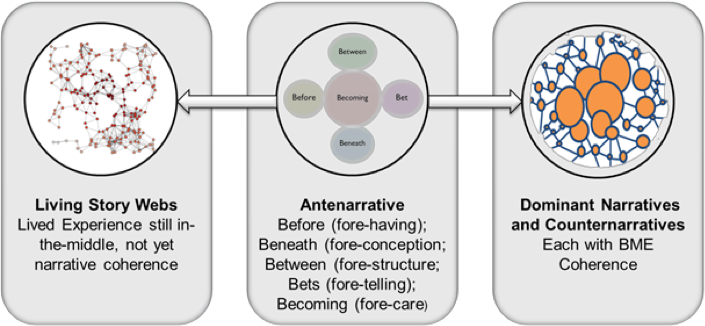
Figure 6: Antenarrative theory of fore-caring (becoming) [Marita Svane (Aalborg University) and I (Boje, 2014) have been developing a model of how Antenarrative operates in the Before, Beneath, Between, Bets, and Becoming. Narratives and Counternaratives get restoried by antenarrative processes.[
ACT 6 in homework: Tie some current applications of Heidegger into your organization systems project: This by the way colleagues and I apply Heidegger for two top-tier journals, in articles I did with Usha Haley (in strategy) on the antenarrative of care, in fore-having, fore-structuring, fore-conception, and fore-sight (or foretelling)"
Haley, U. C.; Boje, D. M. (2014). Storytelling the Internationalization of the Multinational Enterprise. Accepted on May 4th, 2014 at Journal of International Business Studies (JIBS). Click here for pre-publication draft.
Boje, D. M., Haley, U. C., & Saylors, R. (2015). Antenarratives of organizational change: The microstoria of , Vol. 69(2) 391–418. King’s storytelling in space, time and strategic context. human relations, 0018726715585812. On April 15 2015 Journal of Human Relations (a top tier pub on most lists) officially accepted article
recent Human Relations OnlineFirst article that may be of interest to you:
Antenarratives of organizational change. The microstoria of Burger King’s storytelling in space, time and strategic context. Human Relations, published online before print September 29, 2015, doi: 10.1177/0018726715585812 Entire article is here and some of it here:
http://hum.sagepub.com/content/early/2015/09/24/0018726715585812?papetoc for abstract and other access or http://hum.sagepub.com/content/69/2/391.full.pdf+html
Keynote speaker on 23 June 2012 to the 4th International Symposium on Process Organization Studies; Theme: Language and Communication @ Work: Discourse, Narrativity and Organizing, 21-23 June 2012, Kos, Greece. Boje's presentation and film: "Quantum Storytelling: Blacksmithing Art in the Quantum Age." YouTube Film Keynote film.7.4K views5 years agoThis film is dedicated to my great grandfather, William Henry Shelton (born July 26, 1863 in Brownstown, Indiana; died August 18, 1946), who in 1897crossed the Rocky Mountains, with his family, in a covered wagon, and opened the first blacksmithshop and livery stable in Goldendale, Washington. His daughter, my grandmother was a trick rope ride, at a time, as my mother says when 'women did not do that sort of thing'
Figure 7: Some of the D's of quantum storytelling (see Boje, 2014).
I did 5 D's in this article as a bit of humor in relation to the 4 D's of Appreciative Inquiry, a friendly dialectic 88. Boje, D. M. (2011). Reflections: What does Quantum Physics of Storytelling Mean for Change Management?Journal of Change Management, accepted 7/22/2011, Vol. 12 (3): 253-271. Click here for pre-press pdf.
Figure 8: Set of Deseverance Swords, the Heart-of-Care and Spiral of Life as you bring things closer, and join together instead of splitting apart (Boje © 2014).
Here are all 11 D's
Table 1 from Essay https://davidboje.com/Boje/ and see Boje (2014).
The 11 D's are also discussed and developed in a chapter that came out of the PROS conference where I did a video for my Keynote.
Boje, D. M. and Saylors, R. (2013). Quantum Storytelling: An Ontological Perspective on Process. François Cooren, Eero Vaara, Ann Langley, Haridimos Tsoukas (Eds.) Language and Communication @ Work: Discourse, Narrativity and Organizing. London: Oxford University Press. Abstract: The purpose of this chapter is to bring the reader from the present state of storytelling research to the cutting edge of process theory in storytelling. Most importantly, this brings to the surface quantum storytelling. We do this by outlining a three part model of the quantum storytelling process: Empiric Stories, Epistemic Narratives, and Ontological Living Stories; each connected to one-another through the antenarrative process. If these concepts are novel do not worry, we will define them as we go through. We further develop the ontological by delving in to eleven Ds that are manifestations of the ontological. This is a contribution both in terms of advancing narrative analysis and in elucidating the processual dimensions of narrative and storytelling research, thus adding to the conversation surrounding process organization studies.Click here for pre-press pdf.
Finally, I teach the undergrads and MBAs to ask 11 D questions in doing diagnosis for their small business consulting projects https://davidboje.com/448. See for example thier report teamplate
(Arendt) Arendt, Hannah (1958). The Human Condition. Chicago: University of Chicago Press.Arendt was Heidegger's student, then lover, and came to despise Heidegger for overplaying the material (equipmentality) in his ontology, and ignoring the importance of political. Like Follett, Arendt, has a relational process ontology, one that is bound in the politics of power
OTHER HeideggerREADING WE FOR YOUR ENJOYMENT:
Heidegger, M. (1977). The Question Concerning Technology, trans. William Lovitt. NY: Harper and Row. The Turning. on line QCT version is searchable
(BT) Heidegger, M. (1962). Being and Time. Translated by J. Macquarrie and E. Robinson. San Francisco, CA: Harper Collins. see searchable online FREE text) Heidegger develops an ontology approach that is different than Dewey's ontology, and different as well from Follett's ontology. Heidegger's ontology leaves out the political process. It does develop the materiality of equipmentality, and a systems process ontology that is the basis for the Strategy-as-Practice shool of Organization Studies. To develop an ontology such as Follett, Deleuze & Guattari, Dewey, or Barad intra-activity --> we will need to understand their differences (see Table of Differences). For work on Stategy-as-Practice (process) rooted in Heidegerrian process ontology see...
Heidegger, M. (1962). Being and Time. Translated by John Macquarrie & Edward Robinson. NY: Harper Row. 1927 in German, 1962 English translation. see searchable text)
You can also compare the 1962 and 1996 translations. See --> Heidegger, Marin. (1996). Being and Time. Translated by Joan Stambaugh. NY: State University of New York Press. Downloadable pdf that is NOT searchable
QCT Heidegger's Question Concerning Technology is free online in several locations http://www.psyp.org/question_concerning_technology.pdf
